All’s eggcellent atop Campanile for Berkeley’s falcons
Peregrine mates Annie and Grinnell have two eggs, more on the way
March 13, 2020
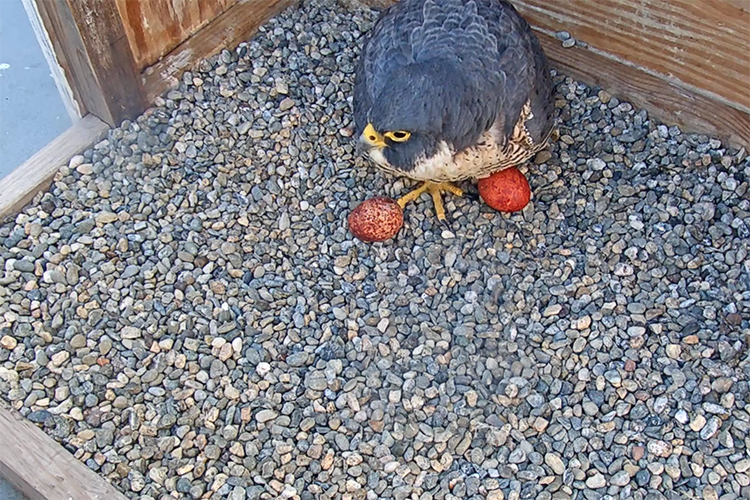
Annie, in her fourth year as a mother falcon, poses with her first two eggs of 2020 — one produced March 10 at 11:21 p.m., the other on March 13 at 9:43 a.m. Additional eggs likely will arrive soon. (Photo courtesy of Cal Falcons)
Coronavirus may be hampering business as usual, but high up in UC Berkeley’s Campanile, peregrine falcon couple Annie and Grinnell — who’ve raised chicks on the bell tower since 2017 — are carrying out their spring routine without a hitch: mating, nesting and reproducing. The first two rusty-brown speckled eggs of the season have appeared — one on Tuesday night, the other this morning (Friday, March 13). The events were captured by one of three webcams on the tower and viewed by the birds’ fan base, which now stretches across 45 countries.
“Congratulations! Our office, along with the rest of Berkeley, is looking forward to meeting our newest residents,” tweeted one admirer, Berkeley Mayor Jesse Arreguin, a campus alumnus.

Peregrines usually mate for life. Annie, seen here soaring above campus, and her mate, Grinnell, began hatching their young on the Campanile in 2017 and continue to make the tower their home. (Photo by Maria Garcia-Alvarez)
“Life goes on. Wonderful,” a Cal Falcons Facebook follower wrote.
Mary Malec, a local volunteer raptor nest monitor who accurately predicted March 10 for the arrival of egg No. 1, said that late Tuesday night this week, “I was getting a little worried, because I had only about half an hour left until midnight. But it arrived at 11:21.”
It takes six to seven days for a full clutch to be laid; the last of Annie’s eggs — if she lays four, she said — could appear next Wednesday. She’ll start incubating them after the third one, so that her young hatch about the same time. People shouldn’t worry, Malec added, if they see Annie occasionally apart from the first two eggs.
“It’s called synchronous hatching, when the chicks are born within a few hours of each other, even though the eggs were laid days apart,” she explained.
Annie and Grinnell “now have quite a bit of experience, so they’re probably at peak of their game, and they’re in the prime of their lives,” said Lynn Schofield, a biologist with The Institute for Bird Populations. She and her husband, Sean Peterson, a Berkeley Ph.D. student in the Department of Environmental Science, Policy and Management, launched the Cal Falcons social media project in 2019. “We hope they’ll get four chicks, that’s the maximum,” she added. “We’re crossing our fingers.”
Last year, Annie produced four eggs, but broke the first one accidentally. Chicks later named Cade and Carson emerged from eggs two and three; the fourth chick didn’t hatch.
Peterson says it’s the perfect time for viewers to check the webcams, as “the laying process is good action. Once Annie starts incubating, she’ll mostly be hanging out for about 32 to 33 days,” until the chicks hatch.
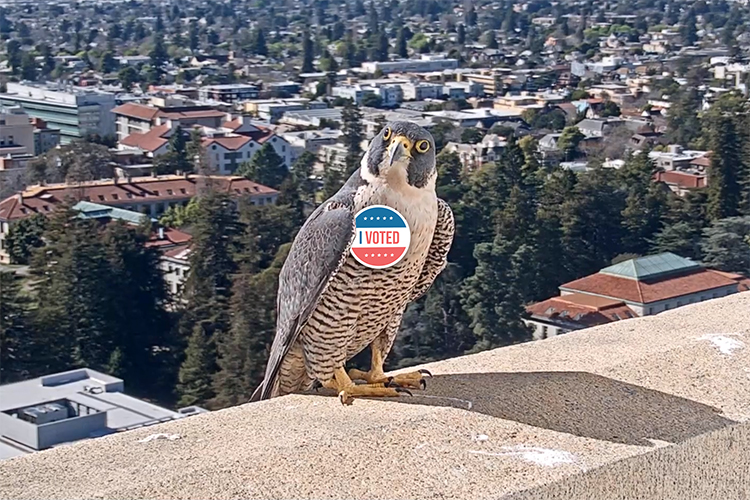
Annie made sure to vote in the March 3 California Democratic primary before returning to the nest to prepare for egg-laying. (Image by Cal Falcons/Sean Peterson)

Mother-to-be Annie contemplated various colors of paint for her nursery on Feb. 20, paint roller ready under her wing. (Image by Cal Falcons/Sean Peterson)
Before the egg-laying began, Annie voted in the California primary election and looked at paint chips for the chicks’ nursery, thanks to social media posts by Schofield and Peterson, who use Instagram, Facebook and Twitter to educate and delight the falcons’ followers — who number in the thousands — with facts, short videos, close-up shots from long-focus lenses and occasional humorous photo-edited images of the birds.
This spring, Cal Falcons is offering new ways to engage with the birds and the scientists and wildlife experts who know them best. As of mid-February, Annie and Grinnell have one-stop shop website with access to their livestreams, Instagram, Facebook and Twitter accounts. There’s also a page to meet the scientists and learn their favorite falcon facts, a list of the partners in this scientific and educational falcon project, a falcon FAQ, a falcon glossary that defines terms like floaters, tiercels and eyrie and an “Ask a Scientist” form.
“It’s so nice to have falcon activity happening on a college campus, where we can aim for education, not just entertainment,” said Malec, who is affiliated with the East Bay Regional Parks District. “Most of our posts are fact-based and pretty interesting and professional.”
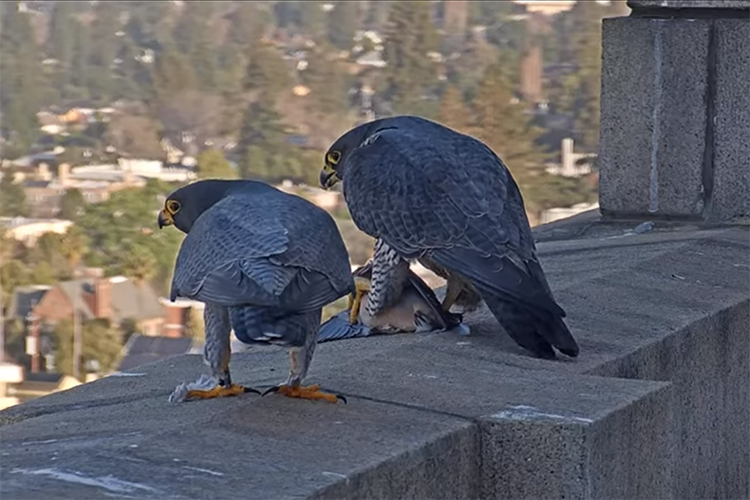
On Feb. 29, Grinnell (left) and Annie feasted on a mourning dove for breakfast. Annie is the larger of the two. Male peregrine falcons can be 50% smaller than females. (Photo courtesy of Cal Falcons)
Another new addition this year is a permanent ethernet cable in the Campanile that will provide a stable connection for the webcams. Campus administrators responded favorably to a request last fall for funding, about $13,000, for the cable, said Carla Cicero, staff curator of birds at the campus’s Museum of Vertebrate Zoology and a liaison to the administration for the coalition of on- and off-campus experts who manage the falcon project.
A Cal Falcons crowdfunding effort in late 2018 raised over $14,500 for the first two webcams and a temporary cable for internet hook-up, which arrived in time for the 2019 nesting season. A third video camera was added last fall, with leftover funds, followed by the long-lasting cable.
That’s good news for those glued to the 24/7 falcon cams. The newest one, for example, allows views of Annie and Grinnell’s day-to-day lives from the tower’s southwest corner, where Grinnell recently brought Annie a red-winged blackbird, shorebirds and acorn woodpeckers to eat.
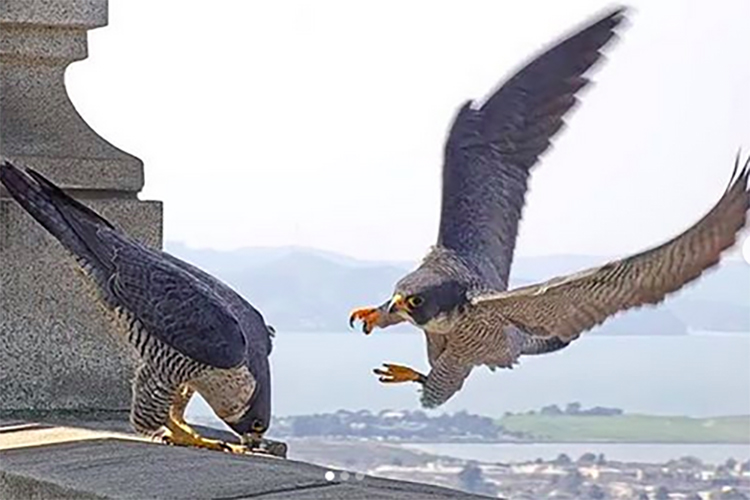
Courting and mating behavior was captured this year by a new and third webcam installed on the Campanile’s southwest corner. Grinnell is on the right, Annie on the left. (Photo courtesy Cal Falcons)
“We’ve seen a lot more prey exchanges between Annie and Grinnell, more courtship behavior and mating and more of where Grinnell is spending time roosting,” said Schofield.
There’s hope that, like last year, a Hatch Day party can be scheduled — in 2019 it was held April 25 at the Berkeley Art Museum and Pacific Film Archive, where the chicks’ emergence was livestreamed on BAMPFA’s giant outdoor screen. The San Francisco Bay Area chapter of the Feminist Bird Club stands ready to offer an additional birding event on campus that day, said Schofield, so that “people can go bird watching around campus and maybe see Grinnell” while Annie’s on the nest.
As in previous years, the baby birds will be named at the beginning of May through a campus community naming competition.
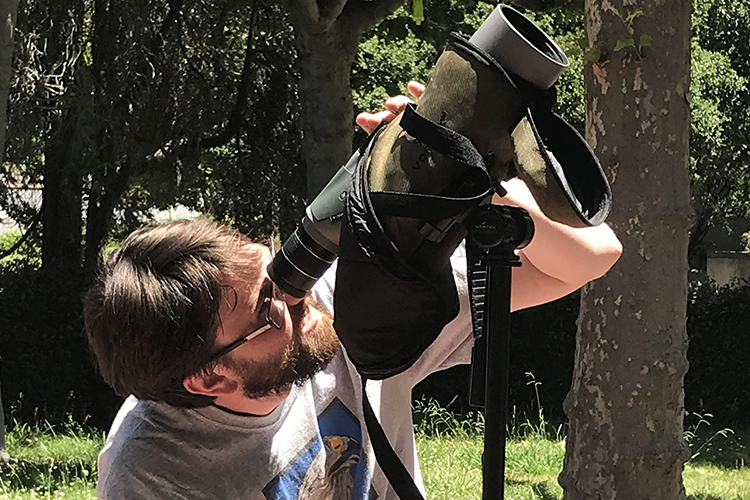
“Neither of us anticipated how much of a following there would be” for UC Berkeley’s falcon family, says Ph.D. student Sean Peterson, of the Cal Falcons social media project he launched in 2019 with his wife, Lynn, a biologist. (UC Berkeley photo by Gretchen Kell)
Cal Falcons will soon launch an online T-shirt fundraiser to support Berkeley’s falcons and their care and keeping. The $20 blue and gold fan gear for kids and adults will sport two falcons swooping around the Campanile.
And, there’s one more update: Annie and Grinnell aren’t just expecting, they’re also expectant grandparents. Lawrencium, or “Larry,” a female born on the tower in 2018, has been living on Alcatraz Island, where researchers performing seabird studies saw her last April with a male falcon sitting nearby. Recently, rangers there spotted her setting up a terrority.
Said Malec, “She seems to be doing all the right stuff.”